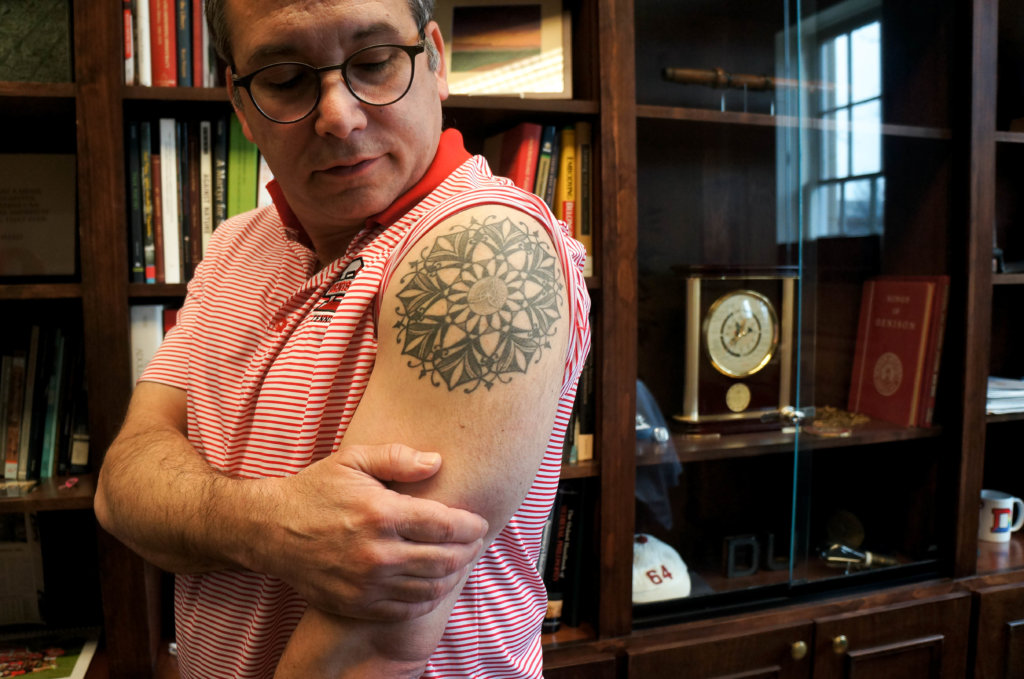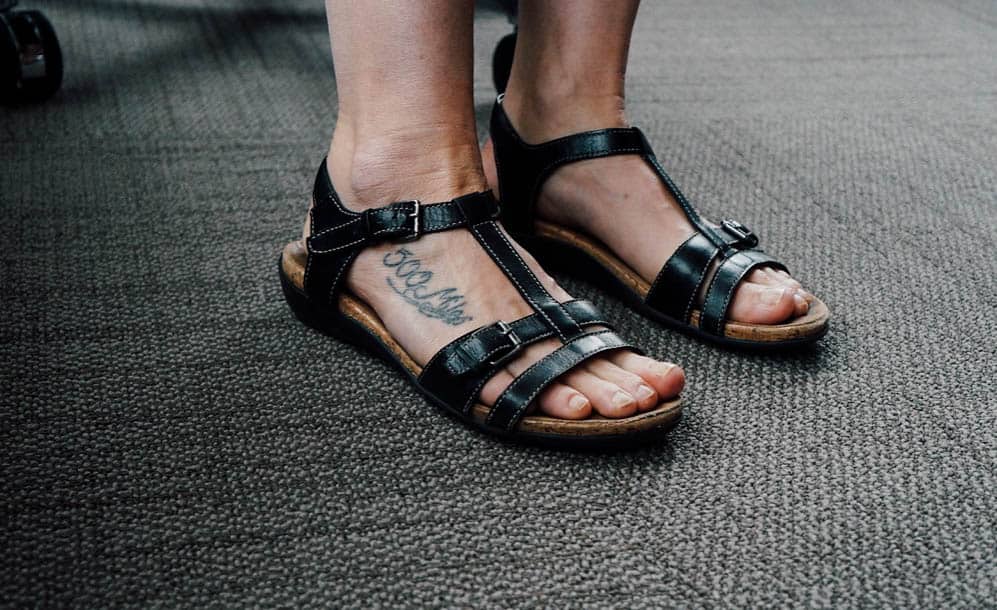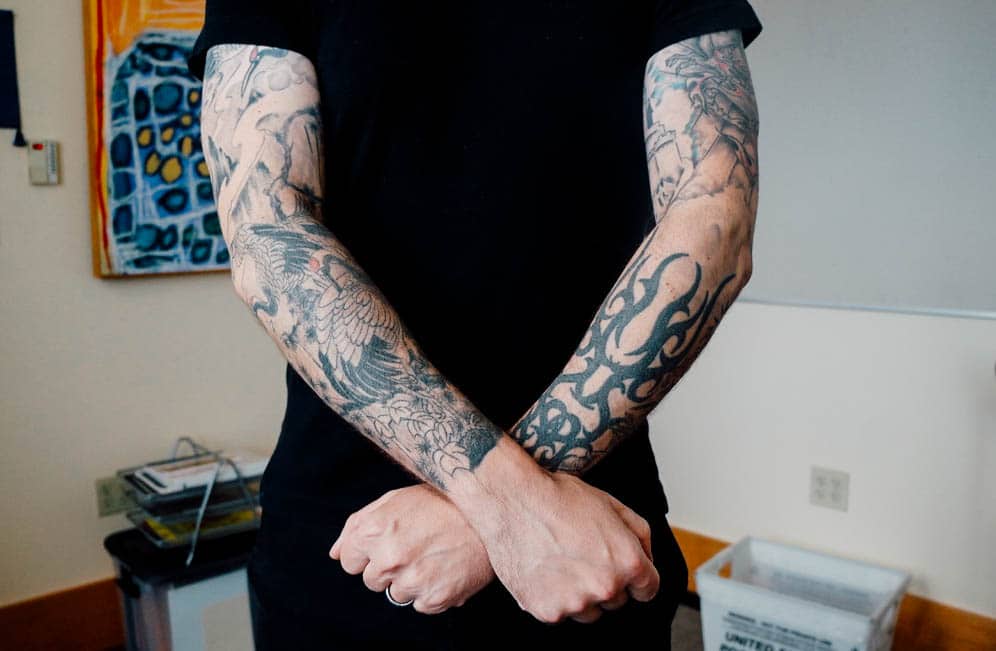ALINA PANEK, NEWS EDITOR — Students often don’t know much about Denison’s administrators, faculty, and staff’s personal lives because of a healthy divide for work-life boundaries. But on a small campus, a feature as vulnerable and precious as body art can be hard to hide when one’s position demands large amounts of time spent on campus and with students.
In interviews with five members of campus including administrators, faculty, and staff, the aim was to learn more about them and how their body art affects their role on campus.
All of these positions are steeped in academia — one of the most prestigious industries one could enter. Their responsibilities include being role models for the student body and frequent presentations. In the ’90s, tattoos had a stigma where the perspective was that mainly bikers, sailors and people who served time in prison possessed them. Another nickname for stick and poke tattoos are “prison tattoos.”
At Denison, administration and faculty have the freedom of expression. There is no mention of the restriction of tattoos in the administrator and faculty code of conduct under Human Resources.
For a wider perspective, the latest respected national study — 2015 Harris study on tattoos nearly half of millennials have tattoos while 36% of Generation X has at least one.
Tattoos are body art that is intriguing as it takes strength to bear the needle, exposing as strangers make judgments and personal details due to their artistry and meaning.
Here are some descriptions and backstories of the tattoos possessed by those in Higher Ed at Denison:
Adam Weinberg
University President

Tattoo Description: A mandala on his left shoulder.
Backstory: “In my early 40s, I had a health scare,” President Weinberg said. “I was fortunate and nothing happened, but I got close. I needed to develop better, stronger and more sustainable habits of wellness and health. My goal was to make it to the 50th birthday with no major health issues. I developed a meditation practice that becomes central to this process. For my 50th birthday, I wanted to celebrate with a tattoo that represented my journey and the meditation practice that has become so central to me as a person.”
Laurel Kennedy
Vice President of Student Development

Tattoo Description: On Vice President Kennedy’s right foot in black cursive it reads “500 miles.” (Fun fact: she has sandals that perfectly frame her tattoo.)
Backstory: The tattoo was Dr. Kennedy’s daughter’s gift to her. “I just had to agree,” Dr. Kennedy said. After they were tattooed, they made a pact for when strangers asked about the tattoo they had to create a story so that they would share what wild stories they told when they were together again. So if you were a friend or a family member, you got the truth. As a compromise, Dr. Kennedy told me two stories: “After my daughter started college,” Kennedy said. “There was mother/daughter tension. We got this tattoo to commemorate when we would dance to the song ‘500 miles’ all the time.” The second explanation she gave was that “We agreed to travel once every 5 years ‘500 miles’ so we’ve gone to places like Charlotte, D.C. and Rockford, IL.”
Chad Buckwater
Assistant Director of International Student Services

Tattoo Description: Buckwater has sleeves and some tattoos on his back. He has spent over 40 hours in a tattoo parlor chair. His left sleeve has four different pieces. “I was an Asian Study major,” Buckwater said, “I was learning about a mixture of different stories.” The sleeve incorporates figures from his studies and life: a dragon, an Asian warrior, cherry blossoms, sword and stone from his favorite childhood story. His right sleeve has three cranes, calligraphy, and pine trees. It was created by Buddhist Monk from central Beijing. “It was done with both stencils and freehand. He had a technique that was super painful but created the effect of beautiful brushstrokes,” Buckwater said.
Backstory: His first tattoo he went with his mother as a birthday present from her. He was 23 years old. He was extremely nervous at the time and he remembers his mother saying, “I can’t believe you’re doing this.” His sleeves were done while he was at an U.S. university and partially while abroad in China. For his left sleeve, “I was in so much pain that I couldn’t even drive my mo-ped home,” Buckwater said. “I had to call my roommate and he drove while my arm was wrapped.”
Eric Winters
Associate Professor of HESS

(Photo courtesy of Alina Panek/The Denisonian)
Tattoo Description: A five-inch donkey on his chest. Fun fact: He has stickers of his tattoo art.
Backstory: “If you have a tattoo you must have a good story,” Professor Winters said. “A donkey in any environment will always progress to get their objective.” He has felt that he has accomplished because of his perseverance, and an “unwillingness to get stuck.” He got his tattoo after he earned a black belt. He was inspired by his teacher who had a large tiger tattoo on his chest. “I saw that and thought ‘that’s awesome’,” Professor Winters said.
Denison Experience: “Many students have no idea that I’ve got a tattoo,” Professor Winters said. “I’ve had a neutral experience. It came up in trivia for HESS but it’s an expression of identity. You should be comfortable and confident otherwise you will regret it.”
Sheila ReStack
Associate Professor of Studio Art

(Photo courtesy of Sheila ReStack)
Tattoo description: Professor ReStack has a total of seven tattoos, and started when she was twenty years old. “Tattoos are a symbol of how I get to redefine myself,” Professor ReStack said. “The more recent ones are less about finding images I like, or establishing connection to social groups, and more about specific people, and the relationship I have with them.” Her favorite, that she described, was the first initial for her daughter and wife. “‘R’ for Rose and ‘D’ for Dani,” Professor ReStack said. “Every time I look down at my hand, I see the two letters. It’s an important connection to them. People you love are part of you, and that is reiterated by the tattoo.”
Backstory: “I got my first tattoo after my third year abroad, in France. I’m from a small rural fishing village in Nova Scotia, and going to get a tattoo was like a declaration that ‘I’m a grown-up! Making decisions my parents won’t like!’” Professor ReStack said.
Denison Experience: “When I first got here, I felt more self-conscious about the tattoos. I had been living in a queer community in New Mexico, and tattoos were commonplace. Ultimately, though, you need to be yourself, and I stopped wearing long sleeve shirts after a couple of years, and figured I don’t’ have to act like I need to hide. In general, students now seem mostly curious. Students will ask about what they mean, and their question will sometimes remind me that I even have tattoos. I don’t mind talking about them, because they’re part of my history. A way to connect to a past self.”

